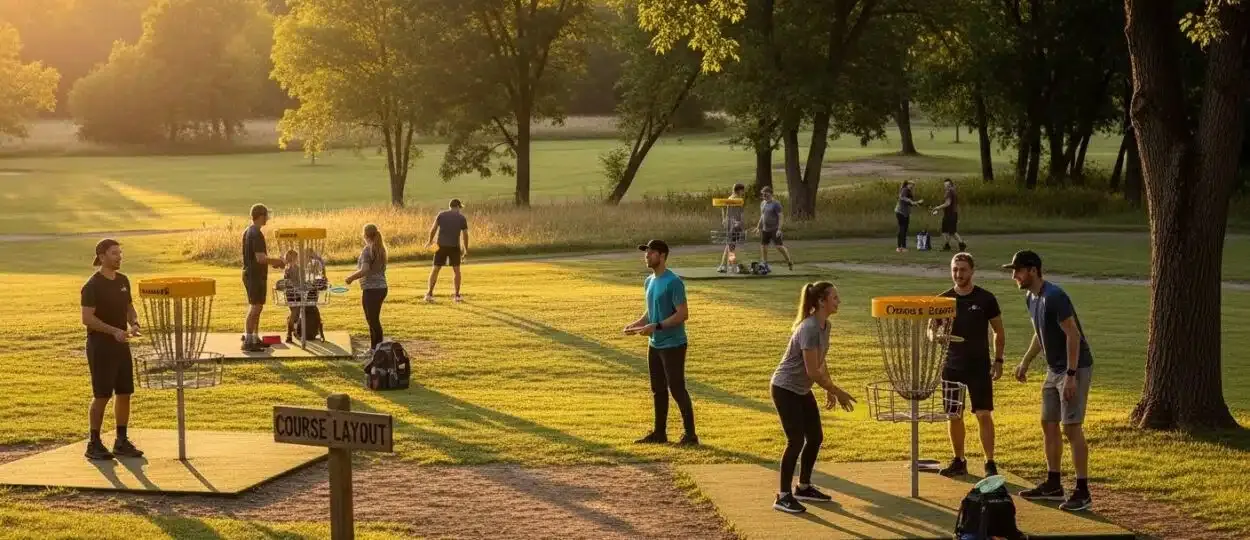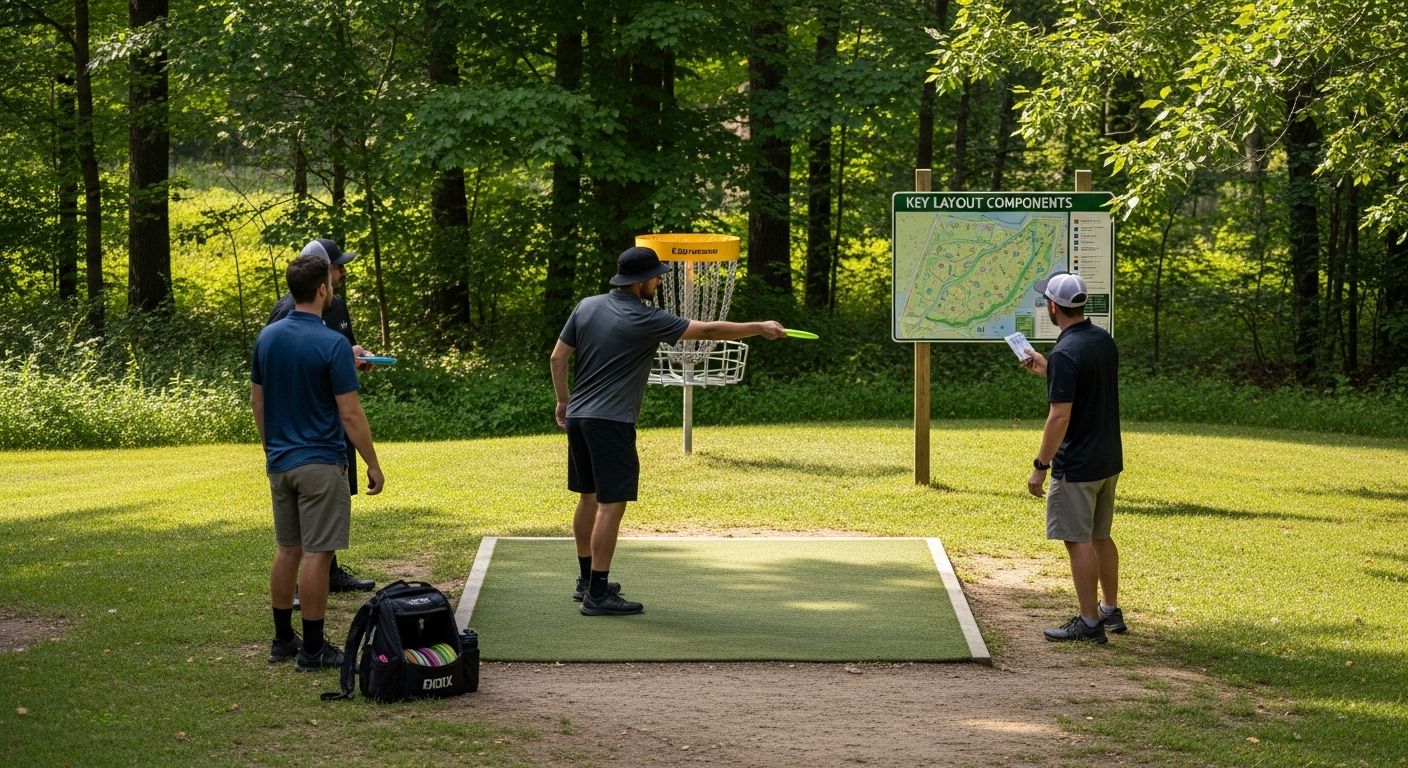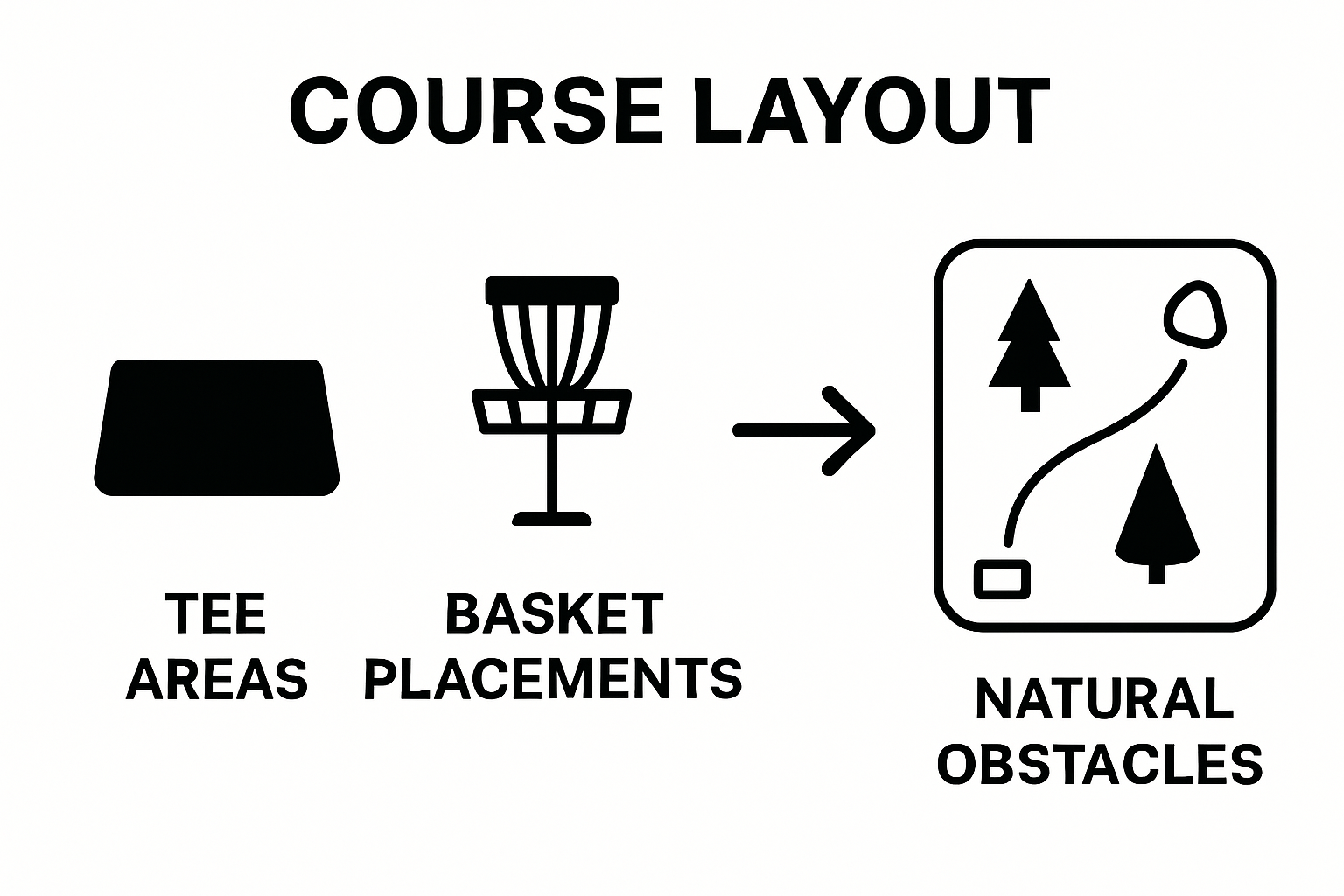
Understanding Disc Golf Course Layout: A Comprehensive Guide
Disc golf course layouts look like simple trails winding through trees but hold more secrets than most people realize. Get this. A standard course often stretches up to 6,000 feet and involves 18 to 24 unique holes, each designed for a different skill and strategy. That is no coincidence. The real trick is not about just tossing a disc from point A to B. The heart of the game lies in how the land is used and how every twist and turn was built to challenge your mind as much as your aim.
Table of Contents
- What Is A Disc Golf Course Layout?
- Why The Layout Matters In Disc Golf
- Key Components Of Disc Golf Course Design
- How Terrain Influences Course Layout
- Real-World Examples Of Effective Course Layouts
Quick Summary
| Takeaway | Explanation |
|---|---|
| Effective layouts enhance player experience | Well-designed courses engage players and promote skill development through unique challenges and terrain features. |
| Terrain features impact gameplay strategy | Elevation changes and natural obstacles influence throwing techniques and player adaptability during matches. |
| Safety is paramount in course design | Adequate spacing and strategic hole placements protect players and spectators, enhancing overall enjoyment of the game. |
| Skill level adaptability is essential | Courses should cater to beginners and professionals alike, ensuring challenges are progressive and suitably difficult for all players. |
| Environmental considerations are crucial | Course designers must balance player enjoyment with ecological preservation, promoting sustainable outdoor recreation in local communities. |
What is a Disc Golf Course Layout?
A disc golf course layout represents the strategic design and arrangement of playing areas where players navigate through a series of holes using specialized flying discs. Unlike traditional golf, disc golf courses utilize natural terrain and landscape features to create unique challenges for players. Learn more about disc golf fundamentals.
Course Design Principles
Designing a disc golf course involves careful planning and consideration of multiple environmental and technical factors. According to the Professional Disc Golf Association, an effective course layout must incorporate several key elements:
- Terrain Utilization: Maximizing natural landscape features like trees, elevation changes, and open spaces
- Safety Considerations: Ensuring player and spectator safety by strategically positioning holes
- Skill Level Adaptability: Creating challenges suitable for beginners through professional players
Typical disc golf courses range from 18 to 24 holes, with each hole presenting a unique trajectory and obstacle challenge. The total course length typically spans between 4,500 to 6,000 feet, allowing players to experience diverse throwing techniques and strategic decision making.
Key Layout Components
A comprehensive disc golf course layout includes several critical components that define player experience and course difficulty. Tee areas serve as starting points, usually constructed with textured cement or artificial turf measuring approximately 6 feet wide and 13 feet long. These designated launch zones provide players consistent footing for their initial throws.
Basket placements represent another crucial element, strategically positioned to create challenging but achievable putting scenarios. Course designers carefully select basket locations that incorporate natural obstacles like trees, bushes, and terrain variations, transforming each hole into a unique navigation puzzle.

Understanding disc golf course layouts requires appreciating the intricate balance between environmental integration, player skill progression, and creative design challenges that make each course a distinctive playing experience.
To clarify the foundational elements that make up a disc golf course, here is a table outlining the key components and their functions as described in the article:
| Component | Description |
|---|---|
| Tee Area | Designated launching point constructed from textured cement or artificial turf, approx. 6×13 ft. |
| Basket Placement | Strategic target location for each hole, often incorporates natural obstacles for challenge. |
| Terrain Features | Natural elements like trees, elevation, and slopes used to shape gameplay difficulty. |
| Player Flow | The logical progression between holes to minimize congestion and support enjoyable play. |
| Safety Measures | Spacing and placement decisions to protect players and spectators from stray discs. |
Why the Layout Matters in Disc Golf
Disc golf course layouts are far more than mere arrangements of baskets and tees. They represent complex design strategies that directly impact player experience, skill development, and overall enjoyment of the sport. Explore essential disc golf techniques to understand how course design influences gameplay.
Player Skill Development
A thoughtfully designed disc golf course layout serves as a critical training ground for players at all skill levels. According to research from the International City/County Management Association, course layouts play a significant role in player progression. The strategic placement of obstacles, variation in hole distances, and incorporation of challenging terrain contribute to skill enhancement:
- Technical Skill Improvement: Layouts that require different throwing techniques
- Strategic Thinking: Courses that demand complex navigation and shot planning
- Physical Adaptability: Designs that challenge players to adjust their approach
Environmental and Community Impact
Beyond player development, disc golf course layouts have broader implications for community spaces and environmental interaction. Well-designed courses can transform underutilized public lands into engaging recreational areas, promoting outdoor activity and community engagement.
Environmental considerations are paramount in modern course design. Course designers must balance player experience with ecological preservation, carefully selecting routes that minimize environmental disruption while creating challenging and enjoyable playing experiences.
Ultimately, a disc golf course layout is an intricate ecosystem of design, challenge, and opportunity. It represents a delicate balance between creating an engaging sporting experience and respecting the natural environment in which the game unfolds.
Below is a table comparing core design considerations and their impact on both gameplay and the surrounding environment, helping readers quickly differentiate these critical aspects:
| Design Consideration | Impact on Gameplay | Environmental/Community Impact |
|---|---|---|
| Terrain Utilization | Influences challenge, throwing styles, and strategic choices | Preserves natural features and landscape integrity |
| Safety Considerations | Enhances enjoyment, reduces player/spectator risk | Minimizes disruptions to other park users |
| Skill Level Adaptability | Ensures inclusive play for beginners to professionals | Attracts broader community participation |
| Environmental Preservation | Requires route selection to limit disruption | Supports ecological sustainability |
Key Components of Disc Golf Course Design
Creating an exceptional disc golf course requires understanding the intricate balance between design principles, terrain utilization, and player experience. Discover essential disc golf techniques to appreciate the nuanced art of course development.
Fundamental Design Elements
According to the Professional Disc Golf Association, disc golf course design encompasses several critical components that transform an ordinary landscape into a dynamic playing environment. Strategic design goes far beyond simply placing baskets and tees, involving complex considerations of terrain, player skill levels, and environmental sustainability.
Key design considerations include:
- Terrain Analysis: Evaluating landscape features like elevation changes, natural obstacles, and vegetation
- Player Flow: Creating logical progression between holes that minimizes congestion
- Safety Parameters: Ensuring adequate spacing between holes and potential hazards
Technical Infrastructure
Tee Areas represent the foundational launching points for each hole, requiring meticulous planning and construction. Professional courses typically feature tee pads measuring approximately 6 feet wide and 13 feet long, constructed from durable materials like textured cement or artificial turf. These carefully designed surfaces provide consistent footing and facilitate precise throwing mechanics.
Basket placements demand equally sophisticated consideration.

Course designers strategically position targets to maximize challenge while maintaining playability, incorporating natural obstacles like trees, slopes, and vegetation to create unique navigation puzzles for players.
The ultimate goal of disc golf course design transcends mere physical arrangement. It represents a holistic approach to creating an immersive, challenging, and environmentally integrated sporting experience that engages players of all skill levels while respecting the natural landscape.
How Terrain Influences Course Layout
Terrain serves as the fundamental canvas for disc golf course design, transforming ordinary landscapes into sophisticated athletic environments. Learn more about disc golf fundamentals to understand how natural topography shapes gameplay.
Elevation and Landscape Dynamics
According to research from the University of Delaware, terrain features are not just obstacles but integral components that define disc golf course complexity. Elevation changes dramatically impact throwing strategies, creating unique challenges that test a player’s technical skills and adaptability.
Key terrain considerations include:
- Vertical Complexity: Utilizing uphill and downhill trajectories
- Natural Obstacles: Incorporating trees, rocks, and vegetation as strategic elements
- Ground Surface Variations: Accounting for different ground textures and slopes
Strategic Terrain Utilization
Advanced course designers view terrain as a dynamic playing field that demands sophisticated navigation. Slope angles influence disc flight paths, with downhill sections allowing longer throws and uphill sections requiring more powerful, controlled launches. Designers strategically position baskets to maximize terrain challenges, creating scenarios where players must adapt their throwing techniques to match the landscape.
Natural features like woodland areas, open meadows, and rocky sections provide unique opportunities for creating diverse and engaging hole configurations. By understanding how different terrain elements interact with disc dynamics, designers can craft courses that are both challenging and environmentally integrated, turning each hole into a unique spatial puzzle that tests player skill and creativity.
Real-World Examples of Effective Course Layouts
Exceptional disc golf course layouts demonstrate the sophisticated interplay between design principles, terrain features, and player experience. Explore advanced disc golf techniques to understand how professional courses elevate the sport.
Championship Course Designs
According to the Professional Disc Golf Association, world-class disc golf courses exemplify strategic design that challenges and inspires players. Professional tournament courses represent pinnacle examples of layout complexity, incorporating multiple design considerations that test athletes’ full range of skills.
Characteristics of championship-level course layouts include:
- Varied Hole Configurations: Requiring multiple throwing techniques
- Strategic Obstacle Placement: Creating complex navigation challenges
- Balanced Difficulty Progression: Testing skills across different stages
Innovative Terrain Integration
Elite course designers transform natural landscapes into sophisticated athletic challenges. The WR Jackson Memorial Course, recognized by the PDGA, demonstrates how terrain can be strategically utilized to create dynamic playing experiences. Woodland sections with strategic tree placements, elevation changes that demand precise throwing angles, and carefully designed basket positions illustrate how landscape features become integral to gameplay.
Natural environments offer unique opportunities for creating memorable disc golf experiences. Courses that seamlessly blend technical challenges with environmental aesthetics not only test player skills but also create immersive sporting experiences that celebrate the intricate relationship between athletic performance and natural terrain.
Elevate Your Game With the Right Disc Golf Gear
If you have explored the complexities of disc golf course layout in our comprehensive guide, you know how much the right equipment can influence your performance. From maneuvering unique terrain to handling tough basket placements, your gear needs to match the challenges each course presents. Many players struggle with inconsistent throws or missed shots because their discs and accessories are not tailored for the technical demands described in our article.

Ready to upgrade your strategy? Visit golfdiscs.com where you will find a top selection of discs and disc golf equipment designed specifically for all skill levels and course conditions. Take the guesswork out of your next round by choosing equipment that supports smart gameplay and helps you master every element of the course layout. Do not delay—equip yourself today and experience improved accuracy and confidence on your favorite courses. Shop the latest disc golf essentials now and translate your course knowledge into lower scores and more enjoyment.
Frequently Asked Questions
What is a disc golf course layout?
A disc golf course layout refers to the strategic design and arrangement of playing areas where players navigate through a series of holes using specialized flying discs, integrating natural terrain and landscape features to create challenges.
How does terrain influence disc golf course design?
Terrain impacts course design by providing unique challenges such as elevation changes, natural obstacles like trees and rocks, and varying ground surfaces. Designers utilize these elements to create engaging hole configurations that test players’ skills.
Why is player skill development important in disc golf course layouts?
Player skill development is crucial because well-designed courses allow players of all skill levels to improve their technical skills, strategic thinking, and physical adaptability through varying challenges and obstacles throughout the course.
What are the key components of a disc golf course design?
Key components include tee areas for initial throws, strategic basket placements to create putting challenges, terrain analysis to assess landscape features, and considerations for player flow and safety between holes.
